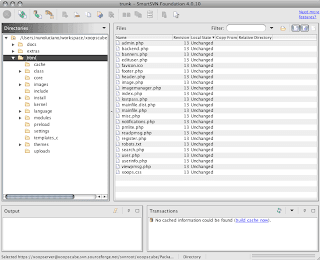

Don’t create a folder in the “branches” folder and then copy each subfolder in trunk into the new folder in the “branches” folder. To create a branch of trunk, copy the entire trunk folder. For example, if you’re adding a big new feature to your website, you can create a branch for this new feature. If you need to make big changes to your trunk that will take a while to complete, it’s best to create a branch and make your changes there. It simply copies files from SVN to your local computer without a version control or history. Applying a patchĮxporting is similar to checking out except it doesn’t create a working copy under SVN control. Select a folder or a file and then click Query > Create Patch. If you want to reverse merge just one file within a revision, when looking at the revision graph, select that file in the list of files in the revision and click the Rollback button.

You can also reverse merge a file by viewing its revision graphĪnd then right-clicking on the revision you want to roll back to. SmartSVN’s reverse merge is inclusive so reverse merging from 13093-HEAD will undo changes in your local working copy including the changes you made in revision 13093. Or, you can reverse merge just changes in one revision several revisions before HEAD. You can reverse merge from HEAD to the revision just before HEAD or to several revisions before HEAD. If you’ve made a mistake in some files that you’ve committed to SVN, you can undo those changes by doing a “reverse merge”. Reverse merging / rolling back (undoing) to a previous revision If you’re happy with the additions (new files) and modifications you’ve made to files you’ve made in your local working copy, you can commit these changes / files to SVN which saves those changes and marks it at a particular revision. Deleting a file from SVN Committing changes from your local working copy to SVN / trunk If you’ve made changes to a file in your local working copy but you no longer want to keep those changes, you can revert the file bring it back to its state before you made any changes to it.

You can click on it to show a diff of the changes you’ve made. If you’ve modified a file in your local working copy, its status will appear as “modified”. In order to save this file in version control, you will need to “add” it and then commit it. When you create a new file in your local working copy, its status will appear as “unversioned”.
#SMARTSVN REMOVE FOLDER FROM WORKING COPY CODE#
You will need to resolve this conflict by choosing which version of the code to keep. you’re changing a line of code that other people have changed, then there will be a conflict. If your changes conflict with other people’s changes, e.g. This will merge their changes into your local working copy files and if there’s a conflict, you would need to resolve them. If you are working on a project with someone else, for example, and they have make code changes which they have committed to trunk in SVN, then you can get their changes by updating your local working copy of trunk. The folder on your local computer is your “working copy” where you make changes. This copies files from your trunk folder in SVN to a folder on your local computer. Following are some common tasks you may need to perform. It makes it easy collaborate on code projects and keep a backup of every change you’ve made. SVN is a version control system often used by programmers to keep track of versions or changes of code.


 0 kommentar(er)
0 kommentar(er)
